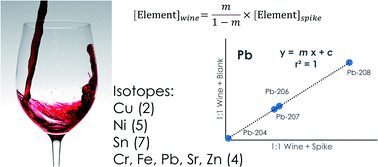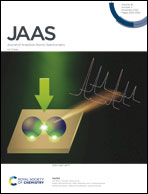Application of multi-isotope calibration to analysis of wine samples by ICP-MS
Abstract
The relatively new multi-isotope calibration (MICal) method was applied to wine samples, measuring elements with potential impacts in sensory perception, wine production and the authentication of origin. Elements in the trace range (100–5000 μg L−1: Cu, Fe, Sr and Zn) and ultra-trace range (1–10 μg L−1: Cr, Ni, Pb and Sn) were analysed by ICP-MS and results from MICal were compared to conventional internal standard (IS) calibration measurements. Analysis of three wines (a red, white and rosé) for Fe and Cu by MICal yielded concentrations that were 100–112% of concentrations established by consensus through a proficiency testing program, but with much less variability than concentrations measured by either IS or consensus results. The same wines spiked with Cu, Fe, Sr and Zn yielded recoveries of 80–106%. Trace elements were measured in a set of 43 wines and ultra-trace elements in a second set of 63 wines by both IS and MICal. Close correlations were observed between the two methods for all elements, although there was a small but significant overestimation of Sr, Cr and Ni by MICal. The MICal method shows promise for rapid quantification of elements in wine, but matrix interferences and isobaric interferences may still affect certain elements. These limitations, and potential remedies, are discussed.



 Please wait while we load your content...
Please wait while we load your content...